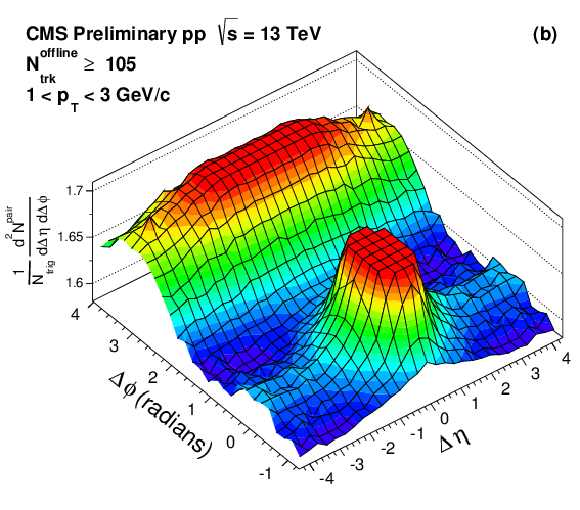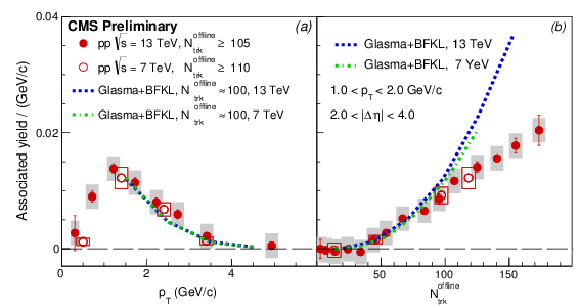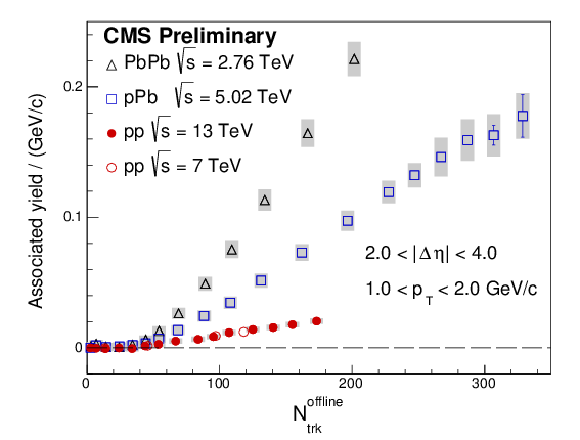

Compact Muon Solenoid
LHC, CERN
| CMS-PAS-FSQ-15-002 | ||
| Observation of long-range near-side two-particle correlations in pp collisions at √s= 13 TeV | ||
| CMS Collaboration | ||
| September 2015 | ||
| Abstract: Results on two-particle angular correlations for charged particles produced in pp collisions at a center-of-mass energy of 13 TeV are presented. The data were taken with the CMS detector at the LHC and correspond to an integrated luminosity of about 270 nb−1. The correlations are studied over a broad range of pseudorapidity (|η|< 2.4) and over the full azimuth (ϕ) as a function of charged particle multiplicity and transverse momentum (pT). In high-multiplicity events, a long-range (|Δη|> 2.0), near-side (Δϕ≈ 0) structure emerges in the two-particle Δη-Δϕ correlation functions. The observed correlations resemble the long-range correlations seen in high-multiplicity pp, pPb and PbPb collisions at lower collision energies. The magnitude of the correlation exhibits a pronounced maximum in the range 1.0 <pT< 2.0 GeV and an approximately linear increase with the charged particle multiplicity. The overall correlation strength at √s= 13 TeV is similar to that found in earlier pp data at √s= 7 TeV, but is measured up to much higher multiplicity values. | ||
|
Links:
CDS record (PDF) ;
Public twiki page ;
CADI line (restricted) ; Figures are also available from the CDS record. These preliminary results are superseded in this paper, PRL 116 (2016) 172302. |
||
| Figures | |

png ; pdf |
Figure 1-a:
The 2D (Δη,Δϕ) two-particle correlation functions in pp collisions at √s =13TeV for pairs of charged particles both in the range 1 <pT< 3 GeV/c. Results are shown for (a) low-multiplicity events (Nofflinetrk< 35) and for (b) a high-multiplicity sample (Nofflinetrk≥ 105). The sharp peaks from jet correlations around (Δη,Δϕ)=(0,0) are truncated to better illustrate the long-range correlations. |

png ; pdf |
Figure 1-b:
The 2D (Δη,Δϕ) two-particle correlation functions in pp collisions at √s =13TeV for pairs of charged particles both in the range 1 <pT< 3 GeV/c. Results are shown for (a) low-multiplicity events (Nofflinetrk< 35) and for (b) a high-multiplicity sample (Nofflinetrk≥ 105). The sharp peaks from jet correlations around (Δη,Δϕ)=(0,0) are truncated to better illustrate the long-range correlations. |

png ; pdf |
Figure 2:
Correlated yield obtained with the ZYAM procedure as a function of |Δϕ|, averaged over 2 <|Δη|< 4 in different pT and multiplicity bins for pp data at √s= 13 TeV (filled circles) and 7 TeV (open circles). The pT selection applies to both particles in the pair. Numbers in brackets indicate the multiplicity range of the 7 TeV data when different from that at 13 TeV. The statistical uncertainties are smaller than the marker size. The subtracted ZYAM constant is given in each panel (CZYAM). |

png ; pdf |
Figure 3:
Associated yield for the near-side of the correlation function averaged over 2 <|Δη|< 4 and integrated over the region |Δϕ|<ΔϕZYAM for pp data at √s= 13 TeV (filled circles) and 7 TeV (open circles). Panel (a) shows the associated yield as a function of pT for events with Nofflinetrk≥ 105. The pT value for each pT bin is the average pT value. In panel (b) the associated yield for 1 <pT< 2 GeV/c is shown as a function of multiplicity Nofflinetrk. The Nofflinetrk value for each Nofflinetrk bin is the average Nofflinetrk value. The pT selection applies to both particles in each pair. The error bars correspond to statistical uncertainties, while the shaded areas and boxes denote the systematic uncertainties. |

png ; pdf |
Figure 4:
Associated yield of long-range near-side two-particle correlations for 1 <pT< 2 GeV/c in pp collisions at √s= 13 and 7 TeV, pPb collisions at √sNN= 5.02 TeV, and PbPb collisions at √sNN= 2.76 TeV. The Nofflinetrk value for each Nofflinetrk bin is the average Nofflinetrk value. The error bars correspond to the statistical uncertainties, while the shaded areas denote the systematic uncertainties. Note that there are PbPb points out of the upper vertical scale, which are not shown for clarity. |
| Tables | |

png ; pdf |
Table 1:
Multiplicity classes used in the analysis, corresponding fraction of the full event sample, observed and corrected average charged particle multiplicities for |η|< 2.4 and pT> 0.4 GeV/c. Systematic uncertainties are given for the corrected multiplicities. |

png ; pdf |
Table 2:
Summary of systematic uncertainties on the long-range, near-side associated yields in pp collisions at √s= 13 TeV. |

|
Compact Muon Solenoid LHC, CERN |

|

|

|

|

|

|